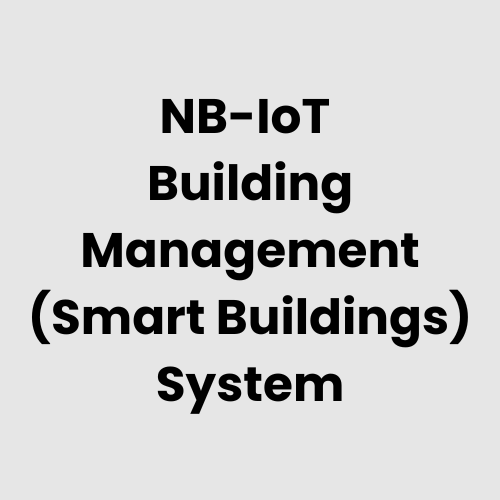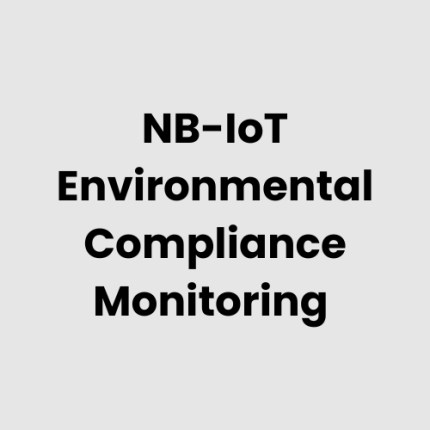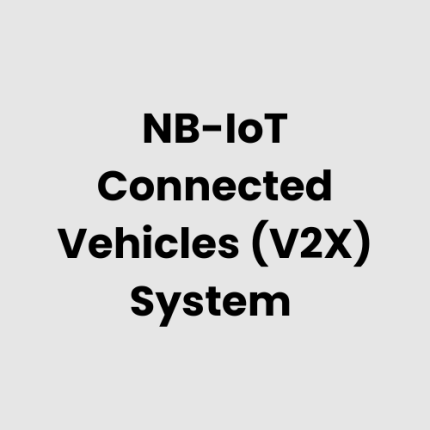Description
Technical Architecture of NB-IoT Enabled Building Management (Smart Buildings) System
The NB-IoT Enabled Building Management (Smart Buildings) System utilizes a comprehensive architecture that integrates IoT devices, sensors, communication modules, local servers, and cloud platforms. The system facilitates the seamless communication of building infrastructure components, such as HVAC, lighting, and security systems, through NB-IoT connectivity. The core components include smart sensors, controllers, gateways, and central management software that enable efficient building operations, energy monitoring, and enhanced security. Through the NB-IoT network, all devices are interconnected, allowing for centralized control and real-time data analytics, ensuring optimal performance and energy efficiency.
List of Hardware for NB-IoT Enabled Building Management (Smart Buildings) System
- IoT Sensors: Temperature, humidity, CO2, motion, and light sensors for monitoring building conditions.
- NB-IoT Modules: Provide connectivity for IoT devices to the NB-IoT network.
- Smart Lighting Systems: Energy-efficient lighting solutions integrated with sensors for smart control.
- HVAC Controllers: Smart controllers for heating, ventilation, and air conditioning systems.
- Smart Locks: Access control systems for securing entrances and rooms within the building.
- Energy Meters: For monitoring and managing energy consumption across the building.
- Gateway: Central hub for connecting IoT devices with the NB-IoT network.
- Local Server: Handles local data storage, analytics, and processing within the building.
- Cloud Server: Stores and processes large-scale data, offering remote monitoring and control.
- Router/Hub: Facilitates communication between devices on the local network.
- Backup Power Supply: Ensures continued operation during power outages.
- User Interface Devices: Touchscreens or mobile apps for user interaction and control.
Physical Placement Considerations of the Hardware
Proper placement of hardware components in the NB-IoT Enabled Building Management System is essential for optimal system performance:
- IoT Sensors: Place temperature, humidity, CO2, and motion sensors in relevant areas like rooms, hallways, and HVAC systems for accurate monitoring.
- NB-IoT Modules: Position these modules in areas with good signal strength and connectivity, such as near gateways or main distribution areas.
- Smart Lighting Systems: Install smart lights where energy management is most critical, such as in common areas and offices.
- HVAC Controllers: Ensure HVAC controllers are placed near the air handling units for direct control over the building’s climate.
- Smart Locks: Place at entry points, doors, and sensitive access areas to secure and control building access.
- Energy Meters: These should be installed at the main electrical panel or in areas where energy consumption monitoring is crucial.
- Gateway: Position in a central location within the building for optimal communication between devices and connectivity to the cloud server.
- Local Server: Install in secure areas with access to network connections and a stable power supply.
- Router/Hub: Position routers or hubs centrally to ensure strong and reliable network coverage throughout the building.
- Backup Power Supply: Place in areas that are not prone to frequent outages, ensuring critical systems continue operating in emergencies.
Hardware Architecture of NB-IoT Enabled Building Management (Smart Buildings) System
The hardware architecture of the NB-IoT Enabled Building Management System is designed to interconnect building systems through NB-IoT modules, sensors, and controllers. The architecture includes:
- IoT Sensors: Collect environmental and operational data from various parts of the building.
- NB-IoT Modules: Enable IoT devices to communicate with the gateway and transmit data over the network.
- Gateway: Acts as a communication hub, connecting local devices with cloud or local servers.
- Local Server: Manages on-site data storage, processing, and system control, reducing reliance on external servers.
- Cloud Server: Manages large-scale data and provides remote monitoring, control, and advanced analytics.
- User Interface Devices: Allow for easy interaction and management by building occupants or administrators.
Deployment Considerations of NB-IoT Enabled Building Management (Smart Buildings) System
Deploying the NB-IoT Enabled Building Management System requires several considerations to ensure a smooth and efficient installation:
- Network Coverage: Verify NB-IoT network coverage in the building area to ensure reliable connectivity for all devices.
- Device Integration: Ensure compatibility between IoT devices, sensors, and controllers to enable seamless operation.
- Scalability: Design the system to accommodate future upgrades or expansions, allowing for the integration of additional devices and functionalities.
- Energy Efficiency: Place energy meters and smart lighting systems in strategic locations to optimize energy use and monitor consumption.
- Security: Implement robust security measures for both physical access control and cybersecurity, including encryption, authentication, and secure data transmission.
- Maintenance: Develop a strategy for ongoing maintenance, including regular checks on devices, firmware updates, and network health.
List of Relevant Industry Standards and Regulations
- ISO 50001 (Energy Management Systems)
- ISO/IEC 27001 (Information Security Management)
- IEC 62368-1 (Safety of Audio/Video, IT, and Communication Equipment)
- IEEE 802.15.4 (Wireless Personal Area Networks)
- 3GPP NB-IoT Standards
- UL Certification (Product Safety Standards)
- FCC Part 15 (Wireless Device Regulations)
- CE Marking (European Product Compliance)
- RoHS (Restriction of Hazardous Substances)
- WEEE Directive (Waste Electrical and Electronic Equipment)
Local Server Version of NB-IoT Enabled Building Management (Smart Buildings) System
In the local server version of the NB-IoT Enabled Building Management System, all data processing and device management functions are handled on-site, reducing dependency on external cloud platforms. This version allows building operators to store and process data locally for real-time monitoring, offering increased control and security. By running on a local server, the system reduces latency, optimizes performance, and enhances privacy, making it ideal for buildings where cloud integration is not preferred or feasible.
Cloud Integration and Data Management
The NB-IoT Enabled Building Management System offers cloud integration for scalable data storage, processing, and advanced analytics. Data from various sensors and devices within the building is securely transmitted to the cloud, where it can be processed for deeper insights into building operations. Cloud-based solutions enable remote monitoring and control, allowing building managers to access real-time data and optimize system performance from anywhere. By integrating cloud platforms, the system can scale efficiently, handle large datasets, and offer advanced analytics, such as predictive maintenance and energy usage forecasts.
GAO Case Studies of NB-IoT Enabled Building Management (Smart Buildings) System
USA Case Studies
- New York City, NY
In a high-rise office building in New York City, the NB-IoT Enabled Building Management System was implemented to enhance energy efficiency and automate lighting systems. Smart sensors monitored environmental conditions and adjusted heating, cooling, and lighting, leading to a significant reduction in energy consumption and an improvement in occupant comfort across the building. - San Francisco, CA
A large tech campus in San Francisco adopted the system to integrate HVAC, lighting, and security systems using NB-IoT technology. This resulted in a unified building management platform that reduced operational costs while enhancing real-time monitoring and reporting for building managers, improving energy usage by 15%. - Los Angeles, CA
A shopping center in Los Angeles leveraged NB-IoT technology to manage lighting and security systems. The integration of smart sensors and energy meters helped the center optimize energy consumption, significantly reducing costs and offering better insights into tenant energy usage patterns. - Chicago, IL
The NB-IoT Enabled Building Management System was deployed in a downtown commercial building to optimize HVAC systems and automate environmental controls. The implementation allowed for remote control and real-time monitoring, improving overall building efficiency and reducing maintenance costs. - Miami, FL
A mixed-use residential and office complex in Miami adopted NB-IoT for intelligent monitoring of energy systems and security. The integration of IoT sensors allowed for real-time data collection on energy usage, helping the building optimize resources and improve sustainability. - Washington, D.C.
In a government office building, the NB-IoT Enabled Building Management System was used to integrate security, lighting, and HVAC systems. The system’s advanced data analytics helped reduce energy waste while providing better management oversight for critical infrastructure. - Dallas, TX
A major healthcare facility in Dallas implemented the NB-IoT Enabled Building Management System to ensure optimal control over medical equipment, HVAC, and lighting. The system provided a scalable solution to improve energy management and reduce operational expenses. - Boston, MA
A prestigious university in Boston utilized the NB-IoT Enabled Building Management System to streamline energy management across several campus buildings. With the integration of IoT sensors, energy consumption was reduced by 18%, and building maintenance became more efficient. - Seattle, WA
An office building in Seattle deployed NB-IoT technology to enhance its smart lighting system and reduce energy usage. By using smart sensors to monitor ambient light, the building’s lighting was automatically adjusted to meet optimal levels, reducing electricity costs significantly. - Denver, CO
In Denver, a corporate office complex adopted the NB-IoT Enabled Building Management System for better control over HVAC and energy monitoring. The system helped the facility manage heating and cooling effectively, maintaining a comfortable environment and reducing costs by 10%. - Phoenix, AZ
The NB-IoT Enabled Building Management System was integrated into a commercial building in Phoenix to enhance energy efficiency and automate building operations. By using real-time data to control HVAC and lighting, the building reduced its operational costs while ensuring a more sustainable building environment. - Atlanta, GA
A business park in Atlanta implemented NB-IoT technology to enhance security and automate the building’s climate control. IoT sensors monitored temperature, humidity, and air quality, adjusting the environment as needed, which improved energy efficiency and occupant satisfaction. - Austin, TX
The NB-IoT Enabled Building Management System was deployed in a high-tech facility in Austin to streamline operations and provide real-time control over building systems. The system’s seamless connectivity allowed building managers to access live data and optimize energy usage and building performance. - Houston, TX
A manufacturing facility in Houston incorporated NB-IoT technology into its building management system to improve energy monitoring and reduce waste. By monitoring power consumption, the system enabled the facility to identify inefficiencies and take corrective actions, leading to a reduction in energy costs. - Minneapolis, MN
In Minneapolis, an office building leveraged the NB-IoT Enabled Building Management System to integrate lighting, HVAC, and energy management. The system allowed for predictive maintenance and proactive management, reducing energy consumption and improving building performance.
Canada Case Studies
- Toronto, ON
In Toronto, a large mixed-use development incorporated the NB-IoT Enabled Building Management System to manage building systems like HVAC, lighting, and energy monitoring. The system’s real-time data analytics helped the building optimize energy usage, resulting in a 12% reduction in operational costs. - Vancouver, BC
A high-rise office tower in Vancouver adopted the NB-IoT Enabled Building Management System for automated building operations. Through smart sensors and integration with the local energy grid, the system enabled better energy efficiency and streamlined operations, ensuring environmental sustainability and cost-effectiveness.
Navigation Menu for NB-IoT
Navigation Menu for IoT
- LORAWAN
- Wi-Fi HaLow
- Z-WAVE
- BLE & RFID
- NB-IOT
- CELLULAR IOT
- GPS IOT
- IOT SENSORS
- EDGE COMPUTING
- IOT SYSTEMS
Our products are in stock and can be shipped anywhere in the continental U.S. or Canada from our local warehouse. For any further information, please fill out this form or email us.
We are actively looking for partners who are like us located in the U.S. and Canada. For more information on partnering with GAO, please visit Partner with GAO Tek Inc. It lists various ways to partner with GAO, such as OEM Partnerships, Technology Integration, Distribution and Reselling Opportunities, Presenting at the Leading Event Tek Summit, Joint R&D Projects, Training and Consulting Services, Industry-Specific Collaborations, Research and Academic Partnerships.



